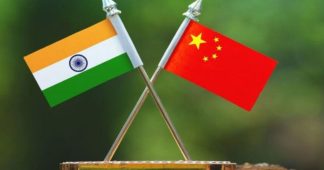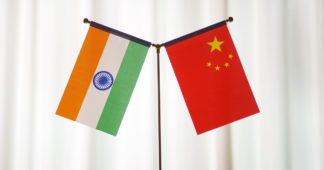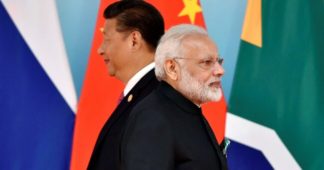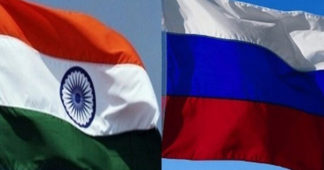Oct 23, 2024
The recent agreement between India and China to restore mutual patrolling rights in Depsang Plains and Demchok in Ladakh marks the first significant breakthrough since the 2020 border crisis. This diplomatic progress, though limited as it focuses only on reversing Chinese transgressions rather than resolving the broader boundary dispute, comes at a strategic time when Indian Prime Minister and Chinese Presidentengaged in their first formal talks in five years on the sidelines of the BRICS summit in Russia.
What is the Significance of China for India?
- Industrial Raw Material Dependency: China has emerged as India’s largest trading partner in the FY 2023-24 with USD 118.4 billion two-way commerce (Global Trade Research Initiative), despite border tensions.
- India heavily relies on Chinese imports for critical industrial raw materials and intermediate goods.
- Over 70% of India’s Active Pharmaceutical Ingredients (APIs) are sourced from China, making the pharmaceutical industry particularly dependent.
- In the financial year 2023-24, India imported electronic components worth over USD 12 billion from China.
- At present, India depends on imports for nearly 80% of its solar equipment, with China supplying over 60% of these imports (Policy Circle Bureau).
- Recent efforts to establish domestic manufacturing capabilities will take years to significantly reduce this dependency.
- Technology and Digital Infrastructure: Despite security concerns and app bans, Chinese technology continues to influence India’s digital landscape.
- Chinese smartphone manufacturers still dominate the Indian market with over 75% market share collectively (Counterpoint Research).
- Critical telecommunications equipment, despite restrictions, often has Chinese components or technology. India’s emerging sectors like electric vehicles significantly depend on Chinese battery technology and components.
Continue reading at www.drishtiias.com
The changing dynamics of India-China relations amidst India-U.S. tensions
Savio Rodrigues
Panaji, Goa: The recent agreement between India and China to restore patrolling arrangements along their disputed border to pre-June 2020 status has marked a significant step toward reducing tensions between the two countries. The deal, finalised on the sidelines of the BRICS Summit in Kazan, came after China finally complied with India’s longstanding demand for disengagement along the Line of Actual Control (LAC). While the agreement is a notable diplomatic achievement, the context in which it was reached reveals deeper geopolitical shifts influenced by deteriorating Indo-US relations.
Since the June 2020 Galwan Valley clashes, which resulted in casualties on both sides, India and China have held multiple rounds of diplomatic and military talks to resolve their border dispute. However, little progress was made until the recent agreement. The breakthrough coincided with a downturn in Indo-US relations, which began to sour following a scandal in the summer of 2023 involving allegations of an Indian assassination attempt on a US citizen with ties to separatist movements.
This incident, coupled with subsequent US actions—including support for Canada in escalating a diplomatic spat with India—fuelled distrust between New Delhi and Washington. As a result, China reassessed its strategic calculus regarding its border dispute with India, no longer perceiving India as a potential partner in the US’ containment policy aimed at countering China’s influence. This shift in perception allowed China to consider a pragmatic approach to the border issue, leading to the recent agreement.
The decline in Indo-US relations played a pivotal role in changing the dynamics of the Sino-Indian border negotiations. Historically, China viewed any concession on the border issue as a sign of weakness, potentially emboldening other regional claimants, such as those involved in the South China Sea disputes. However, the realisation that Indo-US trust had been severely compromised encouraged China to see the border resolution as a strategic move to prevent India from aligning too closely with the US
Continue reading at sundayguardianlive.com
India-China deal raises questions about US Indo-Pacific strategy
By Saibal Dasgupta
Oct. 24, 2024
This week’s movement toward rapprochement between the leaders of China and India is raising questions about New Delhi’s commitment to the Quad, the loose four-nation alliance widely seen as a U.S.-led bid to counter Chinese influence in the Indo-Pacific.
India’s participation in the grouping, which also includes Japan and Australia and is formally known as the Quadrilateral Security Dialogue, has been at least partly driven by a vexing border dispute that has seen repeated clashes between Chinese and Indian troops along their Himalayan border.
Presidents Narendra Modi of India and Xi Jinping of China agreed Wednesday on the sidelines of the BRICS summit in Russia to reduce their differences and jointly work out a plan for patrolling the border. The agreement is expected to result in closer political and economic ties.
“The thaw in India-China relations is a boon to both countries. This is particularly significant for China because India may now be less inclined to confront Beijing as part of Quad,” Zhiqun Zhu, professor of political science and international affairs at Bucknell University, told VOA. “In this sense, the effectiveness of Quad would be diluted with a less enthusiastic India.”
India and China share certain common interests as the two largest developing nations. China was India’s biggest trade partner last year, though there are signs that the U.S. might take its place this year.
Continue reading at www.voanews.com
We remind our readers that publication of articles on our site does not mean that we agree with what is written. Our policy is to publish anything which we consider of interest, so as to assist our readers in forming their opinions. Sometimes we even publish articles with which we totally disagree, since we believe it is important for our readers to be informed on as wide a spectrum of views as possible.











